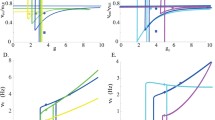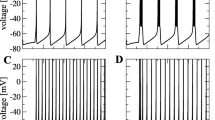Abstract
The question was investigated whether longlasting transients of activity, observed to occur in the intact cerebral cortex (EEG slow (δ) waves and ‘K’ complexes) as well as in isolated tissues cultured in vitro, can also emerge in a model network of excitatory and inhibitory cells. We show that such transients can indeed occur even if the cells do not have built-in slow kinetics. For certain parameter settings, the network is in a bistable state in which periods of increased activity (long-lasting transients) alternate with minimal activity. Transients are triggered by spontaneously firing cells (‘noise’), which, rather than via a build-up of recurrent synaptic inhibition, also initiate their termination. During a transient, the network continually makes transitions from one equilibrium to another as a result of spontaneous firing until it is switched back to the quiescent state, i.e., after a variable period of time of noise-induced transitions the transient is terminated. If the network is small, activity can terminate even without inhibition. In large networks, inhibition keeps the network sensitive to spontaneously firing cells by holding it in the neighbourhood of a critical point between active and quiescent state.
Similar content being viewed by others
References
Abeles M (1982) Studies of brain function, vol 6: Local cortical circuits: an electro-physiological study. Springer Berlin Heidelberg New York, pp 14–15
Abeles M (1991) Corticonics: neural circuits of the cerebral cortex. Cambridge University Press, Cambridge, pp 228–229
Anninos PA, Beek B, Csermely TG, Harth EM, Pertile G (1970) Dynamics of neural structures. J Theor Biol 26:121–148
Anninos PA (1972) Cyclic modes in artificial neural nets. Biol Cybern 11:5–14
Ball G, Gloor P, Schaul N (1977) Cortical electromyography of pathological delta waves in the EEG of cats. Electoencephalogr Clin Neurophysiol 43:346–371
Caianiello ER, Marinaro M (1988) Inverse problem for neural nets and cellular automata. In: Cotterill RMJ (ed) Computer simulation in brain science. Cambridge University Press, Cambridge, pp 260–267
Choi MY, Huberman BA (1983) Dynamic behavior of nonlinear networks. Phys Rev A 28:1204–1206
Clark JW, Rafelski J, Winston JV (1985) Brain without mind: computer simulations of neural networks with modifiable neuronal interactions. Phys Rep 123:215–273.
Connors B, Gutnick MJ, Prince DA (1982) Electrophysiological properties of neocortical neurons in vitro. J Neurophysiol 48:1302–1320
Corner MA, Crain SM (1972) Patterns of spontaneous bioelectric activity during maturation in culture of fetal rodent medulla and spinal cord tissues. J Neurobiol 3:25–45
Crain SM (1976) Electrophysiologic studies in tissue culture. Raven Press, New York
Finkelstein A, Mauro A (1977) Physical principles and formalisms of electrical excitability. In: Geiger RS (ed) Handbook of physiology, Sect 1: the nervous system, vol I: cellular biology of neurons, part 1. American Physiological Society, Bethesda, Maryland, pp 161–213
Grondin RO, Porod W, Loeffler CM, Ferry DK (1983) Synchronous and asynchronous systems of threshold elements. Biol Cybern 49:1–7
Habets A, van Dongen A, van Huizen F, Corner MA (1987) Spontaneous neuronal firing patterns in fetal rat cortical networks during development in vitro: a quantitative analysis. Exp Brain Res 69:43–52
Harth EM, Csermely B, Beek B, Lindsay RD (1970) Brain function and neuron dynamics. J Theor Biol 26:93–100
Kryukov VI (1990) Metastable and unstable states in the brain In: Dobrushin RL, Kryukov VI, Toom AL (eds) Stochastic cellular systems: ergodicity, memory, morphogenesis. Manchester University Press, Manchester
Lopes da Silva FH, Hoek A, Smits H, Zetterberg LH (1974) Model of brain rhythmic activity. The alpha-rhythm of the thalamus. Kybernetik 15:27–27
Mirmiran M, Corner MA (1982) Neuronal discharge patterns in the occipital cortex of developing rats during active and quiet sleep. Dev Brain Res 3:37–48
Nakao M, Takahashi T, Mizutani Y, Yamamoto (1990) Simulation study on dynamics transition in neuronal activity during sleep cycle by using asynchronous and symmetry neural network model. Biol Cybern 63: 243–250
Noest AJ (1988) Power-law relaxation of spatially disordered stochastic cellular automata and directed percolation. Phys Rev 638:2715–2720
Ramakers G, Corner MA, Habets A (1990) Development in the absence of spontaneous bioelectric activity results in increased epileptiform burst firing in cultures of dissociated cerebral cortex. Exp Brain Res 79:157–166
Roth M, Shaw J, Green J (1956) The form, voltage distribution and physiological significance of the K-complex. Electroencephalogr Clin Neurophysiol 8:385–402
Segal SM, Furshpan EJ (1990) Epileptiform activity in microcultures containing small numbers of hippocampal neurons. J Neurophysiol 64:1390–1399
Steriade M, Gloor P, Llinas RR, Lopes da Silva FH, Mesulam MM (1990) Basic mechanisms of cerebral rhythmic activities. Electroencephalogr Clin Neurophysiol 76:481–508
Traub RD, Miles R, Wong RKS (1989) Model of the origin of rhythmic population oscillations in the hippocampal slice. Science 243:1319–1325
Traub RD, Miles R (1991) Neuronal networks of the hippocampus. Cambridge University Press, Cambridge
Wong R, Harth E (1973) Stationary states and transients in neural opulations. J Theor Biol 40:77–106
Van Huizen F (1986) Significance of bioelectric activity for synaptic network formation, Thesis, University of Amsterdam
Van Ooyen A, van Pelt J, Corner MA, Lopes da Silva FH (1992) Long-lasting transients of activation in neural networks. Neurocomputing 4:75–87
Author information
Authors and Affiliations
Rights and permissions
About this article
Cite this article
van Ooytien, A., van Pelt, J., Corner, M.A. et al. The emergence of long-lasting transients of activity in simple neural networks. Biol. Cybern. 67, 269–277 (1992). https://doi.org/10.1007/BF00204400
Received:
Accepted:
Issue Date:
DOI: https://doi.org/10.1007/BF00204400




